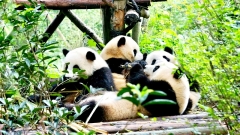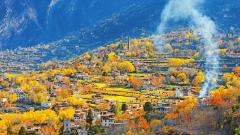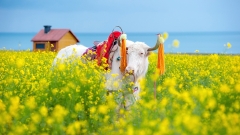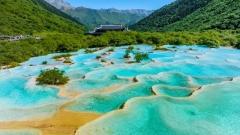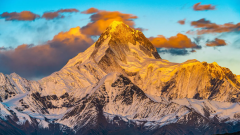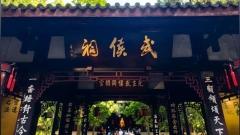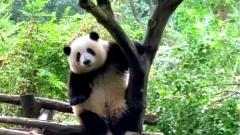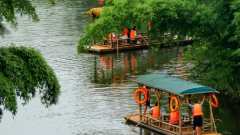Daocheng Yading is one of the most spectacular high-altitude nature reserves in China – a place where towering snow peaks rise from flower-filled meadows, crystal lakes reflect perfect summits, and centuries-old Tibetan culture breathes through humble temples and prayer flags. For international visitors seeking dramatic alpine scenery, spiritual landscapes and authentic Tibetan hospitality, Yading rewards careful planning with visceral memories: sunrise gilding a holy peak, a misty meadow full of wildflowers, or the quiet shimmer of a sacred lake.
Where is Daocheng Yading?
Daocheng Yading refers to the Yading Nature Reserve near Daocheng County in the southern part of Ganzi (Garze) Tibetan Autonomous Prefecture, Sichuan Province. The reserve is famous for its three sacred snow mountains, countless alpine lakes, sweeping meadows and a cultural landscape shaped by Tibetan Buddhism. In 2003 the Yading area was designated part of UNESCO’s Man and the Biosphere (MAB) programme — recognition that reflects the reserve’s unique ecological, scenic and cultural value.
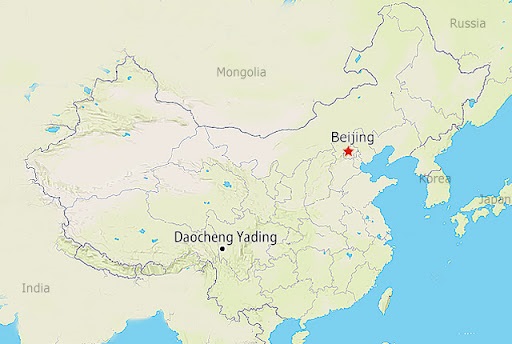
Daocheng Yading Location in China
Why travelers call it “Last Shangri-La”
Western exposure to Yading rose dramatically after the early 20th-century accounts and photos of explorer Joseph Rock brought the highlands’ beauty to international magazines. His images and writing helped link the region with the idyllic “Shangri-La” imagery popularized in the West. The result: Yading developed a reputation as one of the planet’s last pure alpine paradises.
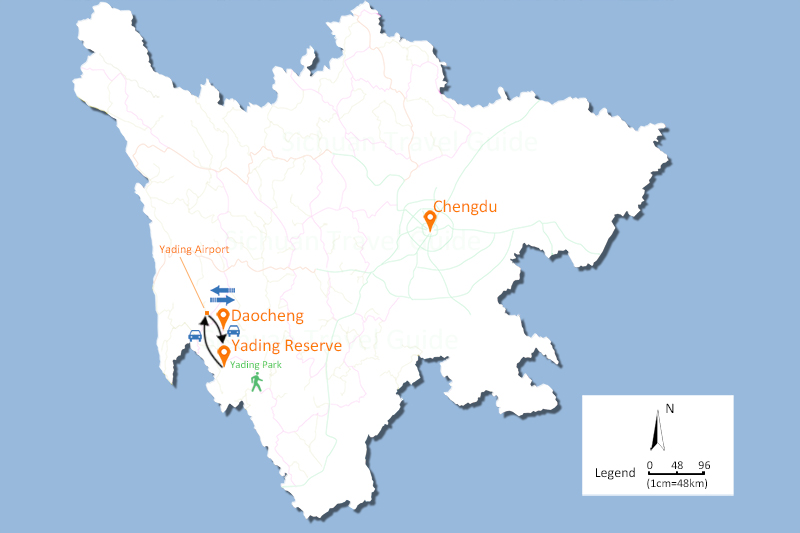
Daocheng Yading Map in Sichuan
Daocheng Yading Highlights: Snow Peaks, Holy Lakes and Sacred Meadows
Three sacred mountains: Chenrezig, Jambeyang, Chanadorje
The three iconic peaks anchor the reserve’s panorama and local spiritual life: Chenrezig (Xiannairi / Shenrezig) — the highest, Jambeyang (Yangmaiyong) and Chanadorje (Shanuoduoji / Vajrapani). These peaks form a rough triangle and are revered as protectors and embodiments of Buddhist qualities. Chenrezig reaches roughly 6,032 m; both Jambeyang and Chanadorje are commonly listed around 5,958 m. Seeing these three peaks together — framed above meadows and lakes — is Yading’s signature sight.
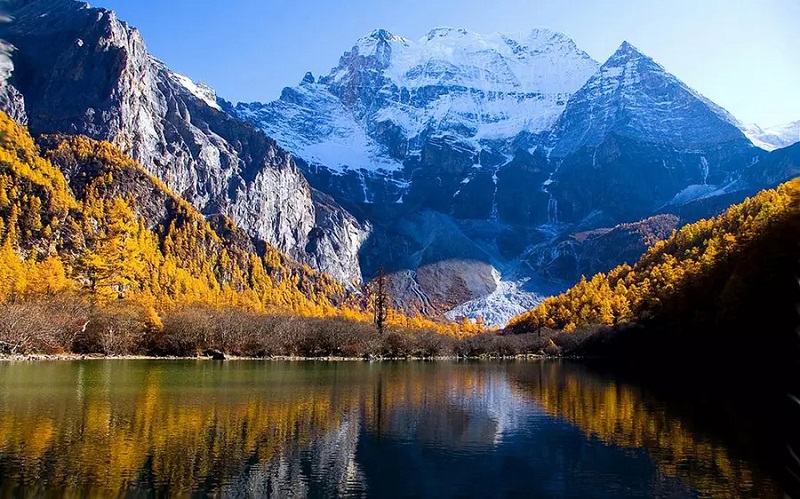
Mount Chenrezig
The holy lakes: Pearl Lake, Milk Lake and Five-Color Lake
Yading’s alpine lakes are glacial jewels. Pearl Lake (Zhuoma Lacuo) is the lowest of the three main lakes (≈4,100 m) and gives one of the best reflections of Mount Chenrezig. Milk Lake (Niunai Hai) and Five-Color Lake (Danzengcuo) sit higher on the Luorong valley trail; their turquoise and prismatic hues against snowy faces are frequently described as “otherworldly.” These lakes are not just scenic highlights — they are living sacred places for local Tibetans.
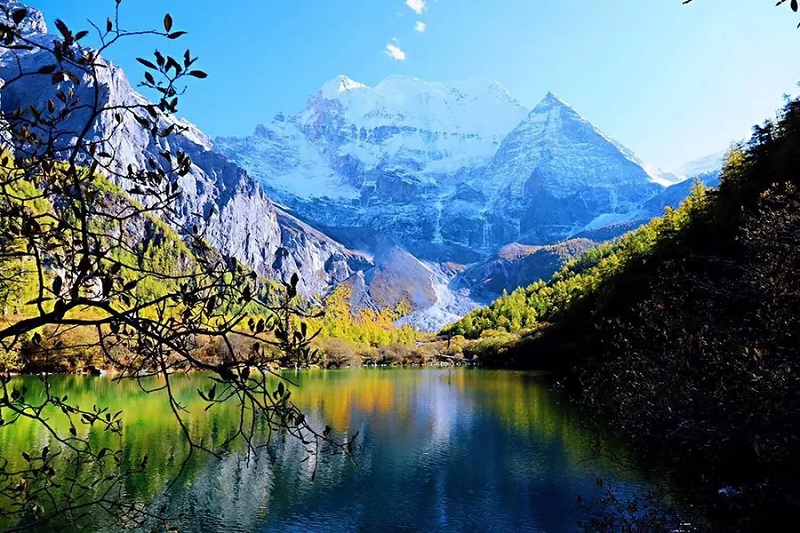
Pearl Lake
Luorong Pasture and Chonggu Temple
Luorong Pasture (≈4,150 m) is the classic meadow viewpoint for catching the three peaks together. Chonggu Temple (≈3,900 m), at the base of Xiannairi, is an atmospheric centuries-old monastery that acts like a gateway to the reserve: prayer flags, butter lamps and the soft scent of yak butter mingle with hikers preparing for the high trails.
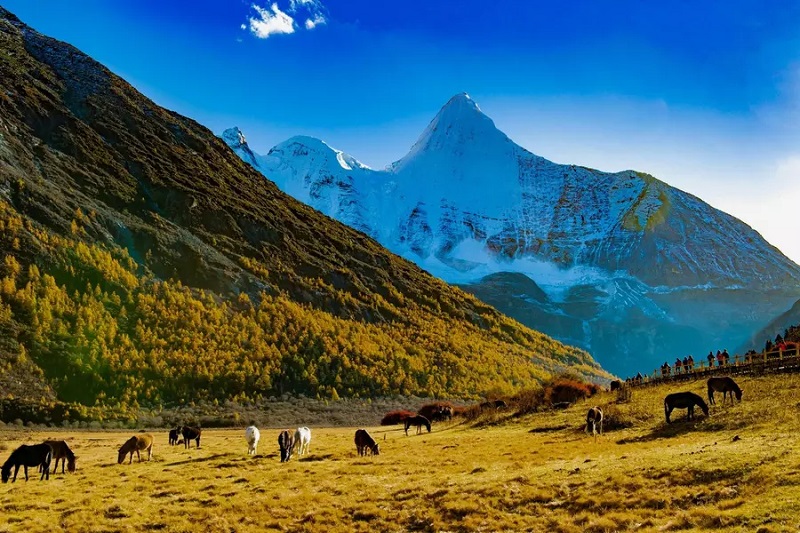
Luorong Pasture
Getting to Daocheng Yading
By plane (fastest, easiest acclimatization)
Daocheng Yading Airport (officially Daocheng Yading Airport) is now connected to Chengdu and several other Chinese hubs. Flights reduce travel time dramatically — what can take several days by road becomes a one-hour hop from Chengdu, followed by a short drive to Daocheng or Shangri-La Town. Flying is recommended if you have limited time or prefer to avoid long road transfers.
By road (scenic, slow acclimatization)
Driving from Chengdu to Daocheng is an epic overland route that many travelers savor. The road distance is commonly reported as roughly 700–820 km by route, depending on the chosen roads; a typical overland itinerary includes stops at Kangding, Xinduqiao, Litang and other highland towns. Road travel gives gradual altitude exposure — a real benefit for acclimatization — but it consumes more time (two to three long driving days minimum).
By bus or mixed transport
Direct long-distance buses run seasonally from Chengdu and other regional hubs. These buses are economical but long and sometimes uncomfortable over mountain passes; they work best when combined with staged overnight stops.
Suggested transfer approach for most international visitors: fly Chengdu → Daocheng, spend a day in Daocheng (or nearby Shangri-La Town) to acclimatize and then begin reserve activities. If you prefer a road adventure, build in several buffer days and stopovers.
Yading Reserve Layout and Trails: Short vs Long Routes
Yading’s core hiking options split into short, accessible loops and longer, more demanding circuits. Below is a practical breakdown so you can align fitness, acclimatization and time.
Short route (half-day to 1 day)
Typical loop: Tourist Center → Yading Village → Zhaguanbeng → Fork Road (electric shuttle) → Chonggu Temple → Pearl Lake (Zhuoma Lacuo) and return. This gentle route is ideal for travelers who want a gentle introduction to the reserve, a close view of Xiannairi and a reflective lakeshore experience without extreme altitude gain. Expect ~3–6 km of walking at average altitudes around 3,800–4,100 m.
Long route (full day — 6–8+ hours)
Typical loop (classic Luorong pilgrimage route): Tourist Center → Yading Village → Zhaguanbeng → Fork Road (electric car) → Chonggu Meadow → Luorong Pasture → Sheshen Cliff → Milk Lake → Five-Color Lake and back. This route covers higher ground (up to 4,500–4,600 m) with steep sections and requires several hours of sustained hiking. If you aim to reach Milk Lake and Five-Color Lake, plan for at least one full day from Luorong Pasture. Trail conditions vary: boardwalks near lower lakes give way to rougher, stony trails toward the high pass.
Multi-day options and pilgrimage style circuits
Active hikers and pilgrims sometimes extend the long route into multi-day circuits that include camping or guesthouse nights near Luorong or in the buffer valleys. Pilgrims may follow kora (circumambulation) paths around sacred peaks; these routes can be physically demanding and spiritually rewarding.
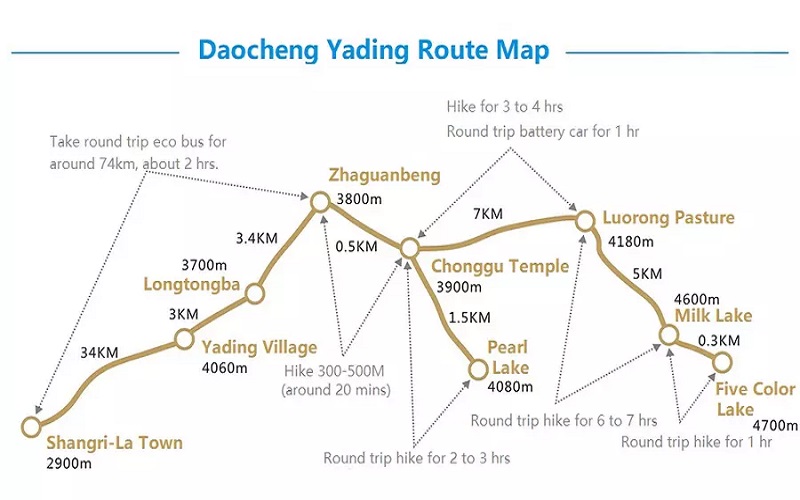
Daocheng Yading Route Map
Where to See the Best Views in Daocheng Yading
Best viewpoint for Mount Chenrezig (Xiannairi) — Pearl Lake & Chonggu Meadow
Pearl Lake’s calm surface creates ideal reflection photos of Xiannairi on clear mornings. Chonggu Meadow (near Chonggu Temple) is a photography and contemplative spot. Walk slowly, take in the midday light and avoid disturbing worshipers who may be making offerings.
Best spots for Mount Jambeyang (Yangmaiyong) sunrise — Luorong Pasture & Luorong Ridge
Luorong Pasture is the classic sunrise vantage for photographing Jambeyang. For clear sunrises the recommended photo time in summer is around 6:00 AM (later in shoulder seasons). Early morning light gilds the peak and paints the pasture gold; bring a headlamp and warm layers for the pre-dawn wait. (Note: exact sunrise times vary by season — check local sunrise times when planning.)
Best viewpoint for Mount Chanadorje — Chonggu Meadow and Chonggu Temple vantage points, Chonggu → Chonggu Rim & Chonggu Terrace
Chanadorje’s dramatic profile, especially in autumn’s rich color, looks stellar from the tree line and from Chonggu approaches. Afternoon to sunset often delivers the most dramatic side-lighting.
Milk Lake & Five-Color Lake — high alpine bowls and reward climbs
Milk Lake (about 4,480–4,500 m) and Five-Color Lake (≈4,600 m) are reached after a steady ascent from Luorong Pasture. These lakes are fragile glacial basins; maintain trail discipline and avoid stepping on fragile vegetation. If you have limited time or fitness, consider renting a horse for part of the ascent from Luorong — but confirm horse conditions, load limits and animal welfare before hiring.
Temples, Pilgrims and Local Tibetan Life in Daocheng Yading
Chonggu Temple and local monastic life
Chonggu Temple is a living monastery with centuries of history; monks practise rituals and locals come for blessings. Respectful behavior is essential: remove hats and shoes when required, avoid loud conversation in prayer halls, and do not step over people or sacred thresholds.
Pilgrimage (kora) traditions around the peaks and lakes
Pilgrims perform kora — full or partial circumambulation — as an act of devotion. You may witness prostrations, prayer wheel rotations and offering rituals. Observe quietly; if you wish to take photos ask permission and be mindful of people performing private rituals.
Villages and homestays: meeting Tibetan families
Local villages near the reserve offer opportunities for soft cultural exchange: tea invitations, simple meals and tales about the mountains. Dress modestly, decline photos if someone seems hesitant, and prefer locally run guesthouses to support the community economy.
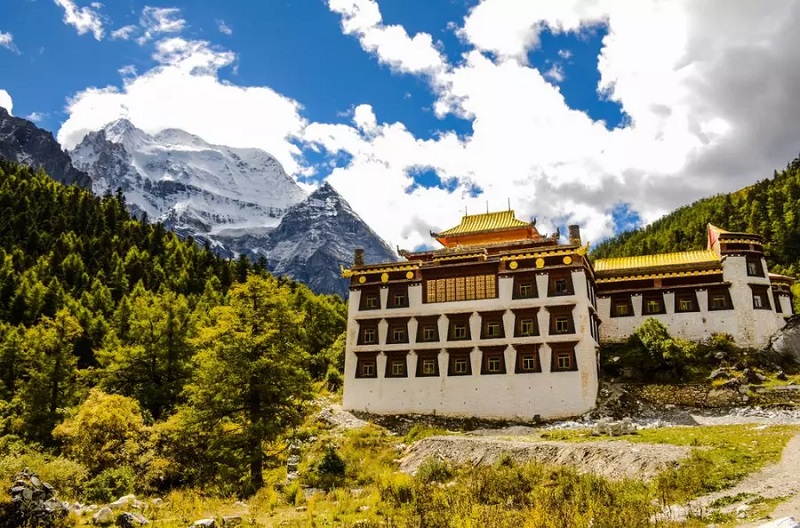
Chonggu Temple
Best Time to Visit & Seasonal Highlights in Daocheng Yading
- Spring (April–June): late spring arrives slowly at altitude; meadows begin to bloom and the air smells of fresh herbs. Snow may linger on higher passes but lower trails open.
- Summer (July–August): lush green meadows and high wildflowers; expect afternoon rains and more clouds. Trails busy during Chinese school holidays.
- Autumn (September–October): widely regarded as the best time — crisp weather, clear visibility and spectacular autumn colors in larches and rhododendrons. Peak photography season.
- Winter (November–March): cold, quiet, often snow-bound roads. Dramatic snowscapes but limited access and harsher conditions.
In general, many guides recommend aiming for spring shoulder months or autumn for optimal weather, color and clearer skies.
Acclimatization, Health & Safety in Daocheng Yading
Why acclimatize slowly
Yading sits at extremely high altitudes — many trails average 4,000 m and lakes exceed 4,400–4,600 m. Altitude sickness (acute mountain sickness) is real, and symptoms can escalate quickly. Build in at least one full acclimatization day after flying in, hydrate, eat light carbohydrate-rich meals, and avoid alcohol.
Recognize symptoms of altitude sickness
Headache, nausea, dizziness, sleeplessness and loss of appetite can be early signs. If symptoms progress (shortness of breath at rest, severe headache, confusion, cough producing frothy sputum), descend immediately and seek medical attention. Portable oxygen can help as a temporary measure; many hotels and tour vehicles in the region keep oxygen on hand. Always travel with a basic first-aid kit.
Travel insurance and emergency prep
Carry travel insurance that explicitly covers high-altitude trekking and medical evacuation. Know the nearest medical facilities (Daocheng County hospital) and share your itinerary with a reliable contact.
Practical Packing List for Daocheng Yading
Clothing & layering
- Lightweight base layers (moisture-wicking)
- Insulating mid-layer (fleece or light down)
- Warm down jacket for nights and early mornings
- Waterproof outer shell (windproof & rainproof)
- Breathable hiking pants and thermal leggings for cold days
- Warm hat, gloves, buff or scarf for wind and sun protection
Footwear & equipment
- Broken-in hiking boots with ankle support
- Trekking poles (highly recommended for steep descents)
- Crampon/traction devices only if visiting in snowy season
- Daypack with rain cover, water bladder and snacks
Sun, hydration & small extras
- High-SPF sunscreen, lip balm with UV protection and sunglasses (UV is far stronger at altitude)
- Water purification tablets or a quick filter (tap water near trails may be untreated)
- Portable oxygen canisters (for emergencies)
- Headlamp, power bank, extra batteries
Documents & money
- Passport and any required Chinese travel documents (visas, local permits)
- Local currency (cash) for remote areas — small shops may not accept cards
- Copies of insurance and emergency contacts
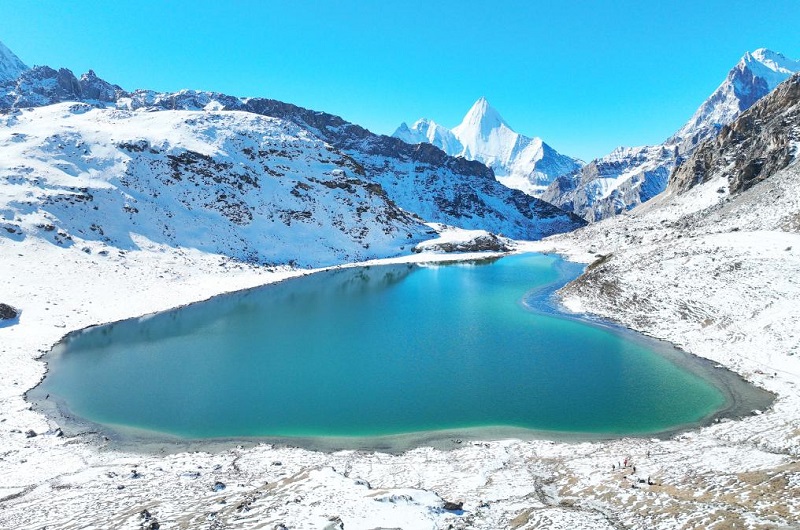
Daocheng Yading in Winter
Food, Accommodation and Local Services in Daocheng Yading
What to eat
Tibetan staples — barley tsampa, butter tea, yak meat stews and simple vegetable dishes — are filling and warming. If you have dietary restrictions, prepare by carrying familiar snack bars and plan ahead at larger towns (Daocheng, Shangri-La) where more variety exists.
Accommodation range
Options vary from basic guesthouses and pilgrim dormitories to boutique lodges that cater to photographers and international visitors. Book peak-season rooms in advance. In remote areas, heating and hot water can be intermittent — carry thermal sleep layers.
Local guides and horse rentals
Guides fluent in Tibetan, Mandarin and basic English are a major asset; they help mediate cultural protocol with temples, arrange horse hires, and judge weather and trail safety. If renting horses for high sections, verify animal welfare, load limits and local standards.
Frequently Asked Questions (FAQ)
Q: Is Daocheng Yading accessible year-round?
A: Technically yes, but winter travel is difficult; roads and passes may close. Spring through autumn offers the most reliable access with autumn (September–October) especially prized for clear skies and color.
Q: How fit do I need to be for the long route?
A: Moderate to good fitness is recommended. Expect long uphill sections at altitude and up to 6–8 hours on steep ground for the Milk/Five-Color Lake loop.
Q: Are English-speaking guides available?
A: In major hubs and with reputable tour operators you can find guides who speak English; hiring one is strongly recommended for cultural mediation and safety.
Q: Can I bring my family with children or elderly relatives?
A: Families can visit the lower loops and lakes, but caution is needed for children and the elderly due to altitude. Consult a physician before travel and plan for gentle daily activities.
Why Daocheng Yading Should Be on Your Bucket List
Daocheng Yading combines dramatic alpine scenery, living Tibetan traditions, and a sense of remoteness that still feels rare in the modern world. It’s a region that rewards patience: more photos captured in golden hours than at midday, deeper memories for travelers who respect local rhythms, and clearer skies after a day of waiting. With smart planning — attention to altitude, considerate cultural behavior and basic preparation — a Yading trip can become one of the most memorable mountain experiences of your life.




